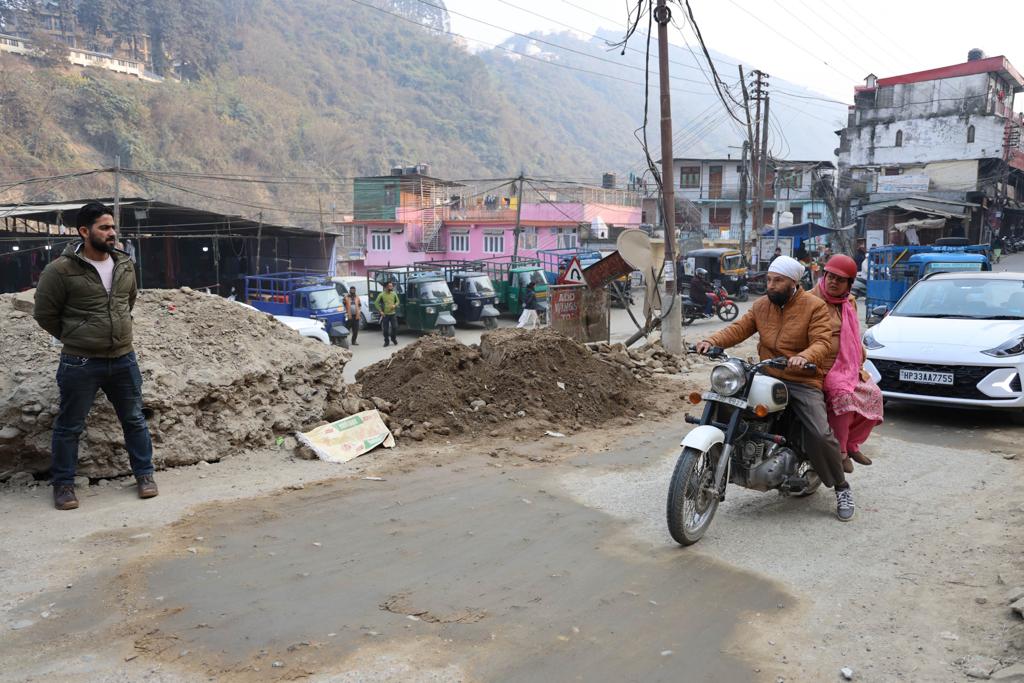Munish Sood
MANDI
Amid persistent rains, nearly 200 devotees of Lord Shiva set out today from the ancient Trilokinath temple in Lahaul, embarking on the revered Thadhi Yatra to Manimahesh Lake. The departure, which coincided with the final day of the traditional Pori Mela, was a deeply emotional moment. Pilgrims, after offering prayers at the temple, were given a rousing farewell with chants of “Jai Manimahesh” reverberating through the valley.
The devotees will now undertake a demanding five-day trek through the Rashel and Kugti mountain passes, traversing steep cliffs, unpredictable weather, and thin air, before reaching the sacred Manimahesh Lake—a glacial water body located at over 13,000 feet in the Chamba district.
The Journey of Faith
The Thadhi Yatra is one of the oldest and most important spiritual traditions of the Lahauli people. Every year, hundreds of men, women, and children join the pilgrimage, regardless of physical hardship. Pilgrims walk for days across rugged terrain, often resting in caves or makeshift shelters along the way.
For the residents of Lahaul, the yatra is not just about ritual but a reaffirmation of their community’s identity and devotion. Despite modernization, roads, and alternative means of transport, the faithful still prefer the traditional route on foot, believing that only through effort and sacrifice does one truly honor Lord Shiva.
Along the journey, devotees stop at sacred points. At Dhanchho waterfall, pilgrims recall legends of Bhasmasura, who was vanquished by Lord Vishnu while chasing Shiva. Near the lake, women bathe in Gauri Kund, believed to be Goddess Parvati’s bathing spot, while men bathe in Shiv Karotri, before finally dipping in the holy lake. Each stop carries deep symbolic meaning, woven into generations of storytelling and belief.
The Sacred Lake and Its Legends
The pilgrimage culminates on Radha Ashtami, observed a fortnight after Janmashtami. On this day, pilgrims believe that the first rays of the rising sun fall on the waters of Manimahesh Lake, turning them into amrit (nectar). A ritual dip in these waters is considered purifying—washing away sins and bringing freedom from ailments.
The lake lies at the base of the towering Manimahesh Kailash Peak, which stands at around 18,500 feet. The peak is regarded as Lord Shiva’s abode and has never been climbed. Local lore recounts that those who attempted to scale it either perished or turned into stone, reinforcing its reputation as unconquerable and divine. The mountain’s gleaming reflection in the lake is often described by pilgrims as a vision of Lord Shiva himself.
According to mythology, Shiva created the lake after marrying Goddess Parvati. The Gaddi shepherd community, who form the backbone of the yatra, consider themselves the Lord’s chosen people. It is said Shiva gifted them their traditional pointed cap and attire, and in return, they began calling their homeland ‘Shiv Bhumi’—the land of Shiva.
Today’s Departure in Lahaul
The sight at Trilokinath this morning was one of devotion and determination. Despite heavy showers, the pilgrims gathered in large numbers, carrying offerings of flowers, incense, and sacred flags. After special prayers at the temple, they set out in groups, many barefoot, singing devotional hymns. Elderly villagers, unable to join the arduous trek, lined up along the temple steps to bid farewell.
“This journey connects us to our ancestors. Rain or snow cannot stop us,” said one devotee before beginning the ascent. For many families, the yatra is also an act of renunciation—pilgrims vow to give up bad habits or seek blessings for children, prosperity, and peace.
A Living Tradition of Lahaul
The Thadhi Yatra is a cultural marker for the Lahauli people. It is common for entire families to participate, passing the tradition down generations. Children often join their parents on shorter stretches of the trek, learning the rituals and legends firsthand. For many, the pilgrimage serves as a rite of passage into adulthood, instilling endurance, faith, and community bonding.
The local administration and community volunteers extend support during the journey by setting up temporary camps, medical facilities, and food stalls. In recent years, heli-services have been made available for those unable to trek, but the majority of devotees still choose to walk, believing the hardships are integral to the blessings earned.
Faith in the Himalayas
The Thadhi Yatra of Lahaul is often compared to other Himalayan pilgrimages such as Amarnath and Kedarnath, but locals insist it holds a unique place. It is the only major yatra where devotees from both Hindu and Buddhist communities walk together, reflecting the syncretic traditions of the valley.
As the chants of “Bam Bam Bhole” echoed across the rain-soaked hills of Lahaul today, the departure of the first batch of pilgrims reaffirmed the enduring faith of a people who, year after year, continue to walk the sacred path of their ancestors. For them, the journey to Manimahesh is more than a trek—it is a union of faith, sacrifice, and cultural memory that lives on with every step taken on the rugged trails of the Himalayas.





